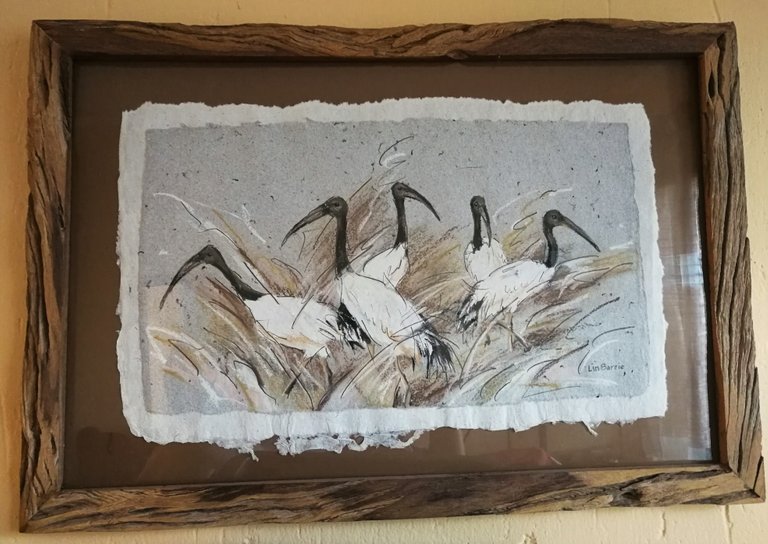Yesterday I was enamoured of a tree, and today, oh fickle me, it's a bird.
The African Sacred Ibis
I even bought a painting of them, I like them so much.

A few quick facts about the African sacred ibis
It's a wading bird, and loves to spend its days in wetlands and roost in trees in or near water. It breeds in Sub-Saharan Africa as well as southeastern Iraq. South African flocks migrate north as far as Zambia, while birds from north of the equator migrate south. It was originally from Egypt where it was mummified (I kid you not) as a votive offering for the god Thoth. They needed to make so many offerings they set up breeding farms throughout Egypt which produced thousands of mummy-ready birds.
It has only recently started to breed in southern Africa, after the beginning of the 20th century, and only since the 1970s have colonies been found in Zimbabwe and South Africa.
Their diet consists mainly of what you'd expect to find in wetlands and mud flats - small fish, frogs, reptiles, insects, worms, crustaceans, molluscs and the occasional small mammal. They might look beautiful, but they won't eschew hanging around dung heaps and garbage dumps.

Frankly, it's not hard to see what the ancient Egyptians saw in them
They're simply beautiful. And blessedly quiet as well, unlike certain other ibis species.

Where do we get to see them?
We'll sometimes see them at the end of a feeding day probing the ground of a nearby school sportsfield with their long beaks for some yummy worms or other insects.
Mostly we see them in flight in the evening.
In the photo below, that fancy-looking building catching the last of the day's rays on the other side of a small river from our house is a church, and it's against this backdrop that I most often watch the sacred ibises heading home, often in large flocks in V-formation.

Their "commute" takes them from their daytime feeding grounds in wetlands to safe roosting spots. The Sacred Ibises like to take their evening commute en flock up the river, and are often outlined against a deep blue sky, foliage warmed and yellow-lit by the setting sun behind us, with their wings almost glowing white as they catch the last rays of the day.

While this is a lovely photo, it doesn't do a flock of sacred ibises justice. Against a blue sky with the setting sun on them, their wings look translucent and oh-so-delicate.
So here's a lovely photo of three of them from earlier this evening. See the three teeny-tiny, itsy-bitsy dots on top of the lowest cloud? That's a completely unrepresentative flock of sacred ibises. Of course they didn't pitch today when I wanted to photograph them, although their noisy cousins the hadedas have been in full voice for the last hour.

At least I know they'll be back on their evening commute soon, and I'll get to marvel at their beauty again. Maybe even get a shot at a (photo!) shot....
References
https://en.wikipedia.org/wiki/African_sacred_ibis
https://www.sa-venues.com/wildlife/birds_sacred_ibis.php

Team South Africa banner designed by @bearone
They are a beautiful bird. Wish we had some here to admire.
Well, you have a pretty impressive bird population where you are! I liked your bird post, @manorvillemike.
Thanks @killgirl